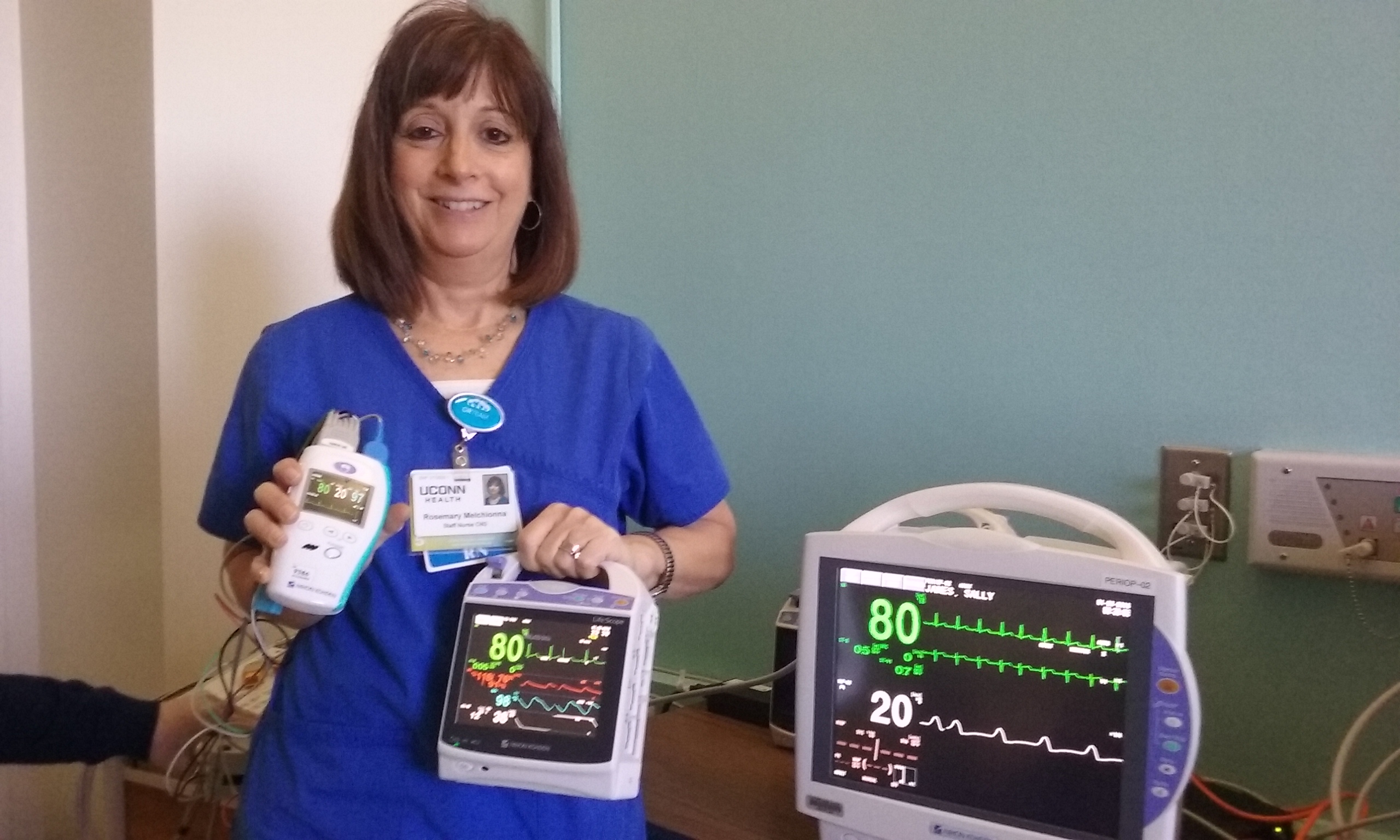
With UConn Health’s new hospital tower comes new systems of information technology designed to enable clinical staff to do even more to enhance patient care, safety and satisfaction.
IT people call them “technology solutions.” Four of them to be unveiled in the new tower make up a suite of compatible applications that collectively will facilitate the timely and efficient communication of critical information and reduce alarm fatigue.
“The introduction of new technology does change how information is shared about our patients’ care,” says IT project manager Ingrid Napoletano. “It should not change our approach to patients’ care, it should only enhance it.”
Patient Monitoring
What is likely to be most noticeable to patients is the increased amount of time their nurses can spend with them, particularly those patients who require special monitoring. A telemetry transmitter accompanies a patient as he or she moves to a medical-surgical room from, for example, the post-anesthesia care unit or intensive care unit. This lightweight device monitors and displays the patient’s heart rate, respiratory rate, oxygen saturation, and it shows electrocardiogram waveforms. They communicate wirelessly with the central monitoring room.
“When the nurse places the monitor on the patient, not only are the telemetry room techs monitoring the patient, but the nurse can see what the techs see,” says Reba Blumenthal with vendor Nihon Kohden.
An additional feature, for when a nurse is not in the room with the patient, is access to recent history on the device. This allows clinical staff to respond to a patient alarm and be able to review the last 10 minutes of numeric and waveform data at the bedside instead of having to leave the patient to go to the central monitoring room to retrieve that information.
The new bedside monitors and transport monitors are from the same vendor. The transport monitors, which go on the stretcher with the patient in transit, are about half the size as their predecessors, and provide access to eight hours of historical data.
The Voalte Phone
The bedside monitors can send messages and alerts to what’s known as the Voalte phone. This is a handheld device that enables nurses to receive notifications, reminders, alarms, and other crucial timely information.
Nurses either carry a Voalte device or use a Voalte app on their own device. In either case they are sending and receiving secure text and voice transmissions.
Nurse Call System

Some of the information transmitted to nurses comes directly from patients. The nurse call system is part of a larger system known as Rauland Responder 5. It not only helps patients communicate with their caregivers, it also helps caregivers communicate with each other.
For example, a button is configured to allow dietary staff to send notification of a patient meal delivery to a nurse’s Voalte phone. The system also enables clinical staff to set reminders to check on patients at timed intervals.
Integrated Connectivity
The nerve center of the operation is the system known as Connexall, which as the name implies, connects Rauland and Nihon Kohden with Voalte.
“Connexall is sort of like a traffic cop,” Napoletano says. “It can assist in directing the messages to the appropriate recipient within the appropriate amount of time based on various criteria defined.”
Nursing staff will be the heaviest users of these tools, which collectively are known as “Connected Care.”
“These technologies will also improve and enhance communications with ancillary areas like lab, radiology, respiratory therapy and pharmacy, as well as provide simple, quick mechanisms to reach physicians and the full care team for a particular patient,” says Roberta Luby, assistant vice president for strategic projects and clinical systems. “We expect these tools will enhance patient care and patient satisfaction.”
Black Diamond Video
Separate from Connected Care, UConn Health also is modernizing the patient’s surgical experience. The operating suites in the new hospital tower will be equipped with monitors that allow a real-time interface with providers throughout the hospital, enabling quicker, more concise communication.

“Black Diamond Video will provide images from medical devices such as x-ray, fluoroscopy, clinical systems, imaging and vital sign monitoring, and pathology, with instant integration,” says IT project manager Carolyn Orrell. “Programmed buttons are used to direct the image for the selected medical equipment or computer to the desired display on the wall or in the surgical field.”
Black Diamond Video uses secure operating systems and encrypted technology. Patient information is blocked on images and recordings. Surgical cases are private and accessible by the surgeon, who can allow access by other credentialed users.
“Technology planning for the new tower started over four years ago,” says Chief Information Officer Jonathan Carroll. “It’s great to see how our technology visioning sessions back then set the stage for us to be at this point. Our original goal of designing a facility with progressive and adaptive technologies that will empower patients and their health care providers to participate together in the healing process is becoming a reality. This is truly an exciting time for those of us involved with the opening of the new patient tower.”



